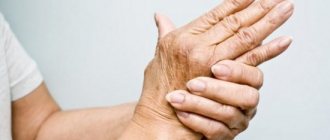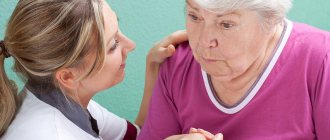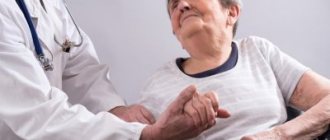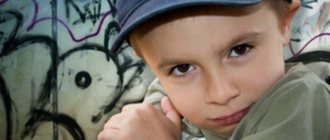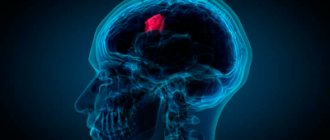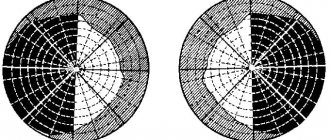Signs of cerebral palsy are a number of symptoms that indicate functional disorders against the background of structural and morphological damage to the brain. In this case, the violations concern specifically defined functions for which the area of the brain that has undergone pathological changes is responsible. Cerebral palsy is always accompanied by certain disorders of the human motor sphere, which are not progressive in nature. This means that a child with cerebral palsy experiences difficulties with a certain category of movements, coordination, and orientation in space. The form and nature of the disorders are directly related to the area of the brain whose neurons were damaged.
Classification of forms of cerebral palsy
Depending on the main cause of cerebral palsy and the location of the brain tissue disorder, several forms of the disease are distinguished based on a number of signs:
- Spastic diplegia is the most common and common form of cerebral palsy. With this type of disease, there is bilateral impairment of muscle function, with the legs, arms and face to a lesser extent being more affected. This form is characterized by skeletal deformities and pathological changes in the joints. Spastic diplegia most often results from the birth of a child with significant prematurity. The disease is often accompanied by a sharp decrease in the motor function of all four limbs, sometimes with partial or complete paralysis (tetraplegia). Against the background of pathology of the cranial nerves, disturbances in speech, auditory and visual functions may develop. With this form of cerebral palsy, if there are no serious impairments in intellectual development and significant impairments in the motor function of the hands, children have the highest chance of social adaptation and self-care.
- Double hemiplegia is one of the most complex and severe forms of cerebral palsy; its development is most often caused by chronic fetal hypoxia during gestation or early infancy (birth trauma). With this form, disorders such as spastic paralysis of all limbs, severe deformities of the torso, and stiffness of the joints develop, which begin to appear at a very early age. Against the background of motor dysfunctions, in approximately half of the diagnosed cases there are serious mental development disorders - cognitive (poor memory, lack of ability to cognition, lack of ability to understand the surrounding world), speech, visual, auditory disorders, pathological changes in the facial muscles, weak swallowing, sucking, chewing reflexes. Often children with this form of the disease suffer from epilepsy. The prognosis for such patients is disappointing; pathologies of motor functions in combination with impaired mental development lead to an inability to self-care.
- The hyperkinetic form is most often caused by hemolytic disease of the newborn, which is caused by an immunological conflict regarding the Rh factor or blood group of the mother and child. In severe forms of the disease, the newborn becomes intoxicated with antibodies from the mother's blood directed against the child's red blood cells. The disease is characterized by excessive motor reactions of muscles, which are caused by impaired muscle tone. Skeletal deformities in this form of the disease are absent or mild. Children experience various types of hyperkinesis - involuntary movements from slow worm-like to fast intermittent, spasms of the facial muscles, cramps of the limbs. Muscle tone can be variable from lethargy and weakness at rest to hypertonicity when moving. Often, with this form of cerebral palsy, hearing impairment and pathologies of motor function of the eyes are observed. Intellectually, such children can develop within normal limits; only the verbal function of communication is impaired with severe dysarthria (impaired pronunciation, speech breathing, articulation, tempo-rhythmic organization of speech).
- The atonic-astatic form is most often a consequence of birth trauma, chronic hypoxia and fetal development abnormalities during pregnancy. In most cases, this form of the disease is caused by damage to the tissue of the cerebellum, sometimes to the cerebral cortex in the frontal region. Children with this form of cerebral palsy are characterized by symptoms such as very low muscle tone, inconsistency of movements, poor coordination, and poor ability to maintain balance when walking. Sometimes speech disorders and intellectual pathologies of varying severity are also observed - from mental retardation to severe forms of mental retardation.
- The hemiplegic form is caused by a hematoma or hemorrhage with damage to one of the hemispheres of the brain, against which unilateral damage to the limbs develops. Hemiparesis (muscle weakening or partial paralysis) of the limbs of the right or left side may be accompanied by spasms and convulsions. In most cases, the motor function of the hand is more impaired. Depending on the degree of damage to the cerebral hemisphere, pathologies of speech function and mental retardation may also be observed.
Diagnosis of the condition
By 12 months of age, a normally developing child can already do a lot. He turns over, sits down, stands up on his legs, tries to walk, pronounces individual words. The baby responds to his name, reacts emotionally to the world around him, and communicates.
Of course, each baby has an individual pace of development. One child can walk with his own legs or start talking earlier, another later. However, CNS pathologies usually appear in aggregate.
Parents should be wary if, at the age of 1 year and older:
- does not crawl and does not try to walk (some children do one thing: either crawl for a long time, or immediately walk);
- cannot stand independently without support;
- does not speak individual short words (“mom”, “dad”, “woof”, etc.);
- does not try to find a toy hidden in front of his eyes, does not reach for flashy things that interest him;
- the baby’s limbs on one side of the body are more active than on the other;
- The child has seizures.
READ MORE: Classification of retinal detachment
By the age of one year, a baby with cerebral palsy usually has all the signs of the disease: non-progressive motor impairment, uncoordinated movements, developmental delay. Diagnostic methods are usually used to confirm the diagnosis, exclude diseases with a similar clinical picture, and clarify the form of the disease. However, making an accurate diagnosis of a baby can be difficult.
The child is examined by a neurologist who will prescribe an MRI - magnetic resonance imaging of the brain. The purpose of this procedure is to identify affected areas of the brain. In addition, MRI helps to determine the presence of changes in the substance of the cortex and subcortex of the brain, as well as to determine their type. This could be, for example, a decrease in white matter density.
The disease is diagnosed based on the identified characteristic signs. Conditioned reflexes and muscle tone are checked, and an MRI of the brain is also taken. If there is a suspicion of brain damage, an EEG and ultrasound are performed.
A timely diagnosis is very important for a young patient. It is important to recognize the disorder. Children should be examined in the maternity hospital; doctors pay special attention to children:
- With light weight.
- Those born prematurely.
- Having defects and developmental anomalies.
- With a diagnosis of newborn jaundice.
- Born as a result of difficult and prolonged labor.
- With infectious diseases.
Cerebral palsy is diagnosed by a neurologist, but he may additionally prescribe other tests to clarify the diagnosis.
Diagnosis of cerebral palsy covers the following stages of analysis:
- Ultrasound of the brain;
- CT and MRI;
- Electroencephalogram.
The main goal of treatment for cerebral palsy is to eliminate malfunctions in the motor system, speech barriers, and correct mental development. Treatment is selected individually, taking into account all the characteristics of each individual organism, because there is no universal treatment today. Methods that accompany positive results:
- physiotherapy;
- medications that normalize muscle tone;
- massage.
The following methods are also effective:
- Voight method;
- Atlant pneumatic suit;
- load suits;
- classes with a speech therapist;
- walkers, bicycles and other exercise equipment.
If the methods do not produce changes, a surgical operation is performed, plastic surgery of the muscle structure and tendons is performed, and the tissues are given the correct shape. In this way, contractures and damaged areas are removed and the spinal cord is stimulated.
Analyzing cerebral palsy, the causes of which can be different, it can be noted that a very effective non-traditional method is animal-assisted therapy - treatment using positive emotions from communication with animals (horses and dolphins).
Cerebral palsy is difficult to treat and the later the diagnosis is made, the less chance there is for recovery and correction of disorders. The most favorable range for complex treatment and correction is considered to be the age period from one month to three years, and it is very important to make a diagnosis and begin treatment in this period.
Treatment of cerebral palsy is a long process. The treatment method is developed by a group of doctors working together. The group includes a pediatric neurologist, a physical therapy doctor, an orthopedic doctor, a speech pathologist, a teacher-educator and a psychologist. When drawing up the methodology, the child’s age, form and severity of the disease are taken into account. Each child with cerebral palsy requires an individual approach.
The main complex of rehabilitation treatment for cerebral palsy consists of three components.
- Medical rehabilitation, which includes the prescription of medications, physical therapy and massage, the use of special therapeutic-load suits and pneumatic suits, physiotherapy, orthopedic and surgical treatment, treatment using orthoses - devices that help make correct movements in the joints.
- Adaptations in the social environment. Teaches children to navigate, adapt and behave adequately in society.
- Psychological, pedagogical and speech therapy correction, which consists of classes with a psychologist, teacher, speech therapist, occupational therapy, training in simple skills and activities with the family.
Among the methods of medical rehabilitation, kinesiotherapy or movement therapy, medications and physical therapy are most often used.
Kinesiotherapy
This is a method of correcting movement disorders and reducing or eliminating the consequences of a sedentary lifestyle.
Types of exercises used in kinesiotherapy.
- Gymnastic. These are exercises that help develop muscle strength, restore joint mobility, and also develop coordination of movements. They are divided into active and passive; static and dynamic.
- Sports and applied. This type of exercise is used to restore complex motor skills.
- Physiotherapy. Teaches you to voluntarily and measuredly tense and relax muscles, maintain balance, normalizes muscle tone and helps get rid of synkinesis, increases muscle strength and restores motor skills.
- Mechanotherapy. Various exercises using simulators and specially designed devices.
Massage
Massage normalizes body functions, improves blood and lymph circulation, and also optimizes oxidation and recovery processes in muscles. Various massage techniques are used in patients with cerebral palsy. The best effect is observed after classical therapeutic massage, segmental massage and massage of the cervical-collar area, circular trophic and acupressure massage, sedative and tonic massage, as well as massage performed according to the Monakov system.
The method is based on the use of a modified penguin space suit for the treatment of patients with cerebral palsy over the age of three. The treatment-loading suits Adele, Regent and Spiral are used for treatment. The duration of the course is 10 - 20 days, the duration of one lesson is 1.5 hours per day. In general, it is necessary to conduct 3 - 4 courses per year.
The duodenum method eliminates pathological (incorrect) position, improves vertical support and motor functions. DPC is contraindicated for up to three years in case of diseases of the spine, hip joints and during periods of exacerbation of diseases.
This is a necessary component of rehabilitation treatment for cerebral palsy.
Several groups of drugs are used for treatment.
- Neurotrophic and nootropic drugs (Cortexin, Pantogam, Phenibut, Picamilon).
- Drugs that improve blood circulation and microcirculation of the brain (Actovegin, Trental).
- Drugs that improve metabolism in nervous tissue, have a resolving effect and restore damaged cells (Lidase).
- Drugs that reduce intracranial pressure (Diacarb).
- Anticonvulsants (Depakine).
- Drugs that normalize muscle tone (Mydocalm, Prozerin).
- B vitamins and Aevit.
Since 2004, in Russia, botulinum toxin A has been successfully used to treat spastic and distant forms of cerebral palsy, which relieves spasticity and muscle stiffness, increases joint movement and improves the child’s mobility, and also eliminates pain. In general, the use of botulinum toxin improves the patient’s quality of life and makes it easier to care for him.
The effect of botulinum toxin treatment is more pronounced when started early. The most optimal age for botulinum therapy is considered to be from 2 to 7 years.
Physiotherapy
The goal of physiotherapy is to increase the performance of cells of the nervous and muscular systems that are not destroyed by damaging factors, and to reduce pain and swelling.
Types of physiotherapy used for cerebral palsy:
- Electrophoresis with various medications that decrease or increase muscle tone, depending on the situation.
- Electrical stimulation of muscle groups. A relaxing or stimulating technique is used.
- Magnetic fields.
MORE: Neuroleptics - list of drugs. Typical, atypical, new generation neuroleptics without side effects
Electrical procedures are not prescribed for patients who have seizures.
- thermal, warming procedures (applications of paraffin and ozokerite);
- mud therapy (wraps and mud baths);
- hydrotherapy (swimming pools, bubble baths, water massage);
- acupuncture;
- treatment with natural factors. This is a sanatorium-resort treatment prescribed to children over three years of age, subject to 2 conditions: absence of seizures and increased intracranial pressure.
Surgical treatment in patients with cerebral palsy is often used to eliminate contractures, curvature of the feet and upper limbs.
Neurosurgical treatment is usually used to correct spasticity or high tone in cerebral palsy.
Orthosis therapy
This is treatment using special devices - orthoses, designed to give the correct position to the musculoskeletal system and correct disorders and curvatures. Examples of orthoses are splints and corsets.
An important component of the complex of rehabilitation for the consequences of cerebral palsy is psychological and pedagogical correction.
Basic principles of psychological and pedagogical correction.
- Complex nature, simultaneous correction of speech, mental and movement disorders.
- Early start of correction.
- Logically consistent principle of correctional work.
- Individual approach to the child's personality.
- Observation and control of the dynamics of psychospeech development.
- Collaboration and unity of the correction carried out with the child and his immediate environment, that is, with the family.
Important importance in correctional work is given to sensory education, which develops the child’s full perception of the surrounding reality. It develops all types of perception (visual, auditory, tactile-motor), forming in the child a complete understanding of the properties of the things and objects around him.
- Development of speech communication and improvement of the intelligibility of spoken words.
- Restoration of normal tone and movements of the speech apparatus.
- Development of voice and speech breathing.
- Synchronization of breathing, voice and speech.
- Correction of incorrect pronunciation.
Signs of early manifestations of cerebral palsy
Manifestations of cerebral palsy include increased excitability and motor disinhibition of nerve impulses, excessive activity and restlessness of muscle reactions, which leads to involuntary and uncontrolled movements. Against the background of increased activity of one muscle group, stiffness and paralysis of other motor functions may occur. In addition, cerebral palsy is often accompanied by disturbances and disorders of mental reactions, provoking abnormalities in the development of speech, hearing, vision and functional disorders of the digestive and urinary systems. Cerebral palsy is often accompanied by seizures of epilepsy.
Symptoms of cerebral palsy can appear in a child immediately after birth, that is, in the first weeks of a newborn’s life. However, it often happens that the manifestation of signs of the disease occurs gradually, which significantly complicates the timely diagnosis of cerebral palsy. In order to take adequate measures to treat and help the child, it is important to recognize them as early as possible.
It is quite difficult to diagnose cerebral palsy in newborn children, therefore, if a child develops symptoms such as sudden convulsions, tremors in the body, sharp muscle contractions, or, conversely, extremely weak motor activity of the limbs, inability to fix his gaze, intermittent, tense or weak breathing, or impaired sucking reflex, parents need to consult a pediatrician and pediatric neurologist.
One of the first manifestations of cerebral palsy in infants is that they begin to develop natural abilities much later. Symptomatically this is characterized by the following signs:
- Delayed motor development - delayed emergence of the ability to raise and hold one's head, development of the skill of rolling over from back to stomach and back, lack of purposeful movements when wanting to reach an object (toy), late development of the ability to sit and hold one's back. In the future, children with cerebral palsy have problems developing the skills of crawling, standing and walking.
- Children with cerebral palsy retain the reflexes that are characteristic of early infants much longer. For example, this applies to a situation where a child older than six months has a grasping reflex. Normally, this reflex is no longer present in children 4-5 months of age.
- Muscle tone disorders. Very often, at the initial stage of cerebral palsy, phenomena such as excessive relaxation or, on the contrary, increased tension of individual muscles or muscle groups can be observed. With this condition of the muscles, the child’s limbs may take on an incorrect, unnatural position. Excessive muscle relaxation in cerebral palsy manifests itself in the inability of normal movement, dangling of one or more limbs, and the inability to maintain a natural body position. Increased tension leads to stiffness and persistent muscle tone, which causes the child’s body to assume a forced, unnatural position. A typical example of such a symptom is arms or legs crossed like scissors.
- Unilateral limb activity. This can be noticed when a child consistently uses only one hand for manipulation. With normal development, children under one year old, if they want to reach an object, use both hands equally, and this factor does not depend on which side of the baby’s brain is dominant. That is, it does not matter whether he is right-handed or left-handed, in infancy he uses both hands with equal activity. If this is not the case, then this factor in itself can be considered alarming.
At the early (up to 5 months) and initial residual (from 6 months to 3 years) stages of cerebral palsy, pathologies of muscle tone provoke disturbances in the child’s motor abilities. This is manifested by the following symptoms:
- Excessive sharpness and suddenness of movements;
- Uncontrolled and completely aimless movements;
- Unnaturally slow and worm-like movements.
Often, even in infancy, children with cerebral palsy exhibit pathological signs such as limb cramps and trembling of individual muscles. This type of disorder affects about 30% of children with cerebral palsy.
Children aged 18 months and older
A child’s development at this age is considered normal if he:
- plays with other people;
- may “throw tantrums”;
- shows love;
- starts working;
- can climb up stairs;
- throws a ball;
- vocabulary is expanding, speaks short phrases;
- begins to create the appearance of a game;
- can jump with two legs.
It should be noted that these stages of development are not comprehensive. Some children reach milestones earlier or later than expected but are still within the normal developmental range.
Late residual stages of cerebral palsy - symptoms
Late stages of cerebral palsy are observed in older children, starting from 3 years. Based on already formed disorders, deformations, limited mobility and stiffness of joints, spasticity and pathological degeneration of muscle tissue, static disorders are established. Their consequence is paralytic and hyperkinetic syndromes.
Late symptoms of cerebral palsy include:
- Skeletal deformities. This type of disorder is observed in children with a spastic form of cerebral palsy. Due to improper movement and imbalance of the muscles, the process of bone formation is pathologically altered. This manifests itself in the form of curvatures, thickening of bones and joints.
- Joint contracture. Stiffness, deformation and pathological changes in joint tissues are caused by inadequate load distribution. In some cases, certain joints atrophy and lose mobility due to impaired muscle tone (myogenic contractures).
- Athetosis. Constant uncontrollable wriggling worm-like movements of the limbs on one or both sides, leading to an unnatural position and deformation (of the hands, feet).
- Ataxia. Characteristic coordination disorders and inability to maintain static or motor balance.
- Pathologies of muscle tone of varying severity. With reduced muscle tone (hypotonia), weakness and sluggishness of movements are observed. With increased tone (hypertonicity) - spasms, convulsions, tremors.
- Hyperkinesis. Involuntary, uncontrollable muscle contractions that cause abnormal movements of certain parts of the body - arms, legs, face.
- Maxillofacial deformities, dentition disorders. They arise as one of the forms of deformation of the skeletal bones of the skull and develop as a result of dysfunction of the facial muscles and other secondary factors of cerebral palsy.
- Delayed mental and mental development. It can manifest itself in various forms depending on the type and severity of damage to brain tissue - disturbance of spatial concepts, disorders of the emotional-volitional sphere, difficulty concentrating and switching attention, low memory capacity, lack of interest and motivation for learning.
In addition to the signs described above, it is important to note disturbances in visual functions (strabismus, optic nerve atrophy, myopia), hearing and speech development. In severe forms, functional disturbances in the processes of urination and bowel movements are also possible.
Spastic paralysis/hemiparesis
This type of cerebral palsy usually affects the shoulder and hand on one side of the body, but it can also affect the leg. In premature infants, it is usually caused by periventricular hemorrhagic infarction (in most cases, unilateral) and congenital cerebral anomaly (for example, schizencephaly) or ischemic infarction.
Children with spastic hemiplegia tend to walk later and walk on their toes due to a tight heel tendon. Patients with this diagnosis often have significantly shorter and thinner limbs than children without developmental disabilities. A number of patients develop scoliosis (curvature of the spine).
Based on the above, the level of social adaptation of a child, as a rule, is determined not by the degree of motor defect, but by the intellectual development of the patient. Focal epileptic seizures often occur;
Cerebral palsy - the main causes of development
The causes of the disease in the vast majority of cases are provoked by complications during pregnancy and pathologies in the first weeks of the baby’s life. The causes of cerebral palsy primarily include severe illnesses and pathological conditions that a woman suffered during pregnancy. The first group includes various infectious diseases that lead to intrauterine infection of the fetus. They are especially dangerous during the formation of brain structures.
The second group of reasons that provoke morphological and structural changes in the fetal cerebral cortex during pregnancy include traumatic brain injuries, falls, blows with the risk of brain injury in the child.
The main causes include the following factors:
- Prematurity and, as a consequence, underdevelopment of the brain;
- Chronic fetal hypoxia, causing oxygen starvation of the brain;
- Severe form of toxicosis;
- Severe infectious diseases;
- Lack of vitamins during intrauterine development;
- Severe chronic systemic diseases of the mother;
- Incompatibility of the blood of mother and fetus by Rh factor or group;
- Genetic predisposition (hereditary factor);
- Poisoning with toxic substances, heavy metals, medications.
The causes of postpartum brain tissue damage are most often associated with severe, protracted labor, birth injuries, asphyxia and infection of the baby in the first days of his life.
Hyperkinetic type of disease
The hyperkinetic form (dyskinetic form) of cerebral palsy has the following symptoms:
- involuntary movements of the limbs;
- incorrect positioning of the legs;
- violations of the correct posture of the spine;
- slow movements;
- convulsions;
- speech disorder.
Article on the topic: Clostilbegit - instructions for use for men, composition, release form, dosage and price
This type of cerebral palsy has a slight effect on the child’s intelligence, so the child can study quite successfully at school, have quite normal contact with others, and successfully adapt to society.
The cause is hemolytic disease complicated by kernicterus. Subcortical structures are affected.
Advantages of osteopathy in the treatment of cerebral palsy
Like any severe neurological pathology, cerebral palsy is treated comprehensively using drug therapy, physiotherapy, massage techniques and physical therapy. Most of the developed methods of traditional medicine are aimed at relieving complications, improving blood supply to the central nervous system, as well as correcting pathological motor patterns.
Surgical treatment is used to eliminate severe deformities of joints and bones. However, all these methods only help eliminate the consequences and complications of the disease. It is worth noting that many of these treatments have a number of side effects and can be quite painful for the child.
Unlike classical medicine, osteopathic techniques make it possible to directly influence the causes of certain disorders, thanks to this they always have a much more effective result. Classification of osteopathy:
- Structural osteopathy - this set of techniques is used in the treatment of various diseases of the musculoskeletal system and the musculoskeletal system, both with limited and unlimited mobility.
- Craniosacral osteopathy is the use of various techniques for the treatment of neurological pathologies, including in children with impaired motor-sensory development, mental retardation and problems of social adaptation.
- Visceral osteopathy is a set of measures to influence the internal organs and functional systems of the body.
Methods of structural and craniosacral osteopathy are used to treat children with motor dysfunction caused by deformation of the skeleton, trunk and joints, as well as pathologies of muscle tone. For pathological complications of the functions of internal organs, visceral osteopathy techniques are used.
One of the important advantages of osteopathy is rightly considered to be the possibility of early diagnosis of diseases of the nervous system and damage to brain tissue. Even modern neurological diagnostic techniques can identify pathology from a certain age of the child, and an osteopath can distinguish disorders at the stage of very early development.
When diagnosing the nature and cause of disorders, the osteopath identifies specific areas of damage and develops an individual course and precise treatment regimen for each patient. For example, when a certain muscle group is blocked, techniques are initially used to relieve tension in muscle fibers or tightness of nerve endings. Relaxation makes it possible to improve blood flow and oxygen supply to damaged tissues. Subsequently, techniques are used to restore normal blood supply and nutrition to nerve tissue.
For each type of disorder in osteopathy, specific treatment and recovery methods have been developed. If a child at an early age develops such disorders as delayed physical or mental development, pathologies of reflexes, motor visual and auditory anomalies, then osteopathic methods can help to promptly influence the causes, up to their complete elimination.
The sooner a child receives help, the higher the chances of normal development and further socialization. An osteopathic doctor always collaborates with other specialized specialists - a neurologist, psychiatrist, ophthalmologist, orthopedist. The most effective results are obtained by combining the methods of classical medicine and osteopathy.
Massage and exercise therapy according to D. Sandakov - video
Courses
for cerebral palsy, children begin to undergo treatment from the age of 1.5 months. Classical massage, segmental, acupressure, with liquid nitrogen (cryomassage) and the Manakov technique are successfully used. Massage should be performed only by a specialist who can adequately assess muscle tone, degree of impact, frequency of sessions, etc. Parents are not recommended to massage their child with cerebral palsy themselves.
Therapeutic physical education for cerebral palsy must be included in the complex of therapy, and it must be systematic and regular. The set of exercises and their complexity are established for each child individually, taking into account all his characteristics, age, level of mental development and the course of the disease. Physical exercises are performed in doses, the load increases gradually as the condition improves.
Children with cerebral palsy must perform the following physical exercises:
- stretching;
- muscle relaxation and decreased tone;
- increasing the amplitude and range of muscle movements of various parts of the body;
- strengthening the muscles involved in the movements of various parts of the body;
- exercises to develop muscle endurance;
- training of a normal muscle stereotype for proper walking;
- balance training by walking on inclined planes;
- exercises to increase muscle strength.


